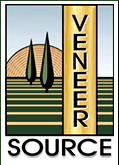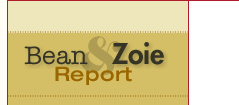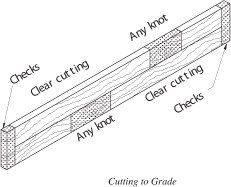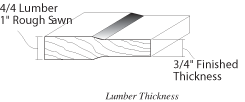







 QSI Lumber Grades
QSI Lumber Grades
The tables that follow establish standards of quality for QSI Lumber Grades I, II, and III.
NOTE: These Grades do not relate to the various published lumber association grading rules. Such saw mill grades are notbased upon the use of the whole board, but rather the percentage of the board that can be realized by cutting out the defects.
For architectural woodwork purposes, the appearance of the
piece in the final end product is what is important, and notwhether it was cut from a larger board that contained defects that could be eliminated.
The Standards establish the sizes of pieces which must be furnished free and clear of all natural or seasoning characteristics that are considered undesirable and therefore classed as defects.
- The Standards limit the extent of such defects that will be permitted in boards larger than the required size;
- The Standards apply only to those surfaces visible after assembly and installation;
- The Standards do not apply to special varieties of species that display unusual characteristics and that are desirable for æsthetic and design reasons. These include Knotty Pine, Wormy Chestnut, Pecky Cypress, Wattled Walnut, various burls, etc. If their use is contemplated, individual ranges of characteristics and availability should be investigated and specified accordingly;
- No decay is allowed in any Grade;
- All lumber will be furnished plain sawn unless otherwise specified.
 Lumber is rough sawn and marketed in commercial thickness expressed in quarter-inch increments. After sawing, lumber must
Lumber is rough sawn and marketed in commercial thickness expressed in quarter-inch increments. After sawing, lumber must
be dried and machined for end use purposes, producing the following finished thicknesses.
For responsible utilization of natural resources, gluing for thickness is permitted at the
 option of the woodworker, as follows:
option of the woodworker, as follows:
- Hardwoods may be glued for thicknesses exceeding 27 mm [1-1/16"].
- Softwoods may be glued for thicknesses exceeding 38 mm [1-1/2"]
- Adhesives -when intended for exterior use, Type I assemblies must be used. Otherwise, adhesives are at the option of the woodworker.
- Match for glued pieces intended only for transparent finish:
Grade I - pieces shall be well matched for color and grain.
Grade II - pieces shall be compatible for color and grain.
Grade III - no matching for color or grain required.
Lumber Width
Architectural markets for hardwood and softwood lumber can be entirely different from each other. Softwoods are mainly sold as nominal width boards, derived from Imperial measure, i.e.:
 1 x 4 (3/4" x 3-1/2") [19 x 89 mm]
1 x 4 (3/4" x 3-1/2") [19 x 89 mm]- 1 x 6 (3/4" x 5-1/2") [19 x 140 mm]
- 1 x 8 (3/4" x 7-1/4") [19 x 184 mm]
- 1 x 10 (3/4" x 9-1/4") [19 x 235 mm]
- 1 x 12 (3/4" x 11-1/4") [19 x 286 mm]
Hardwood lumber, on the other hand, is cut and sold to yield the maximum usable material. Each board is sawn as wide and long as the log and grade allows, then trimmed just enough to make the edges and ends true. This production method satisfies the major hardwood markets; at the same time limiting waste and reducing costs.
NOTE: In the absence of either drawing details scaled 1-1/2" = 1'-0" (or larger); or specification; or drawing notations of dressed sizes, references to the width of members shall be construed to be nominal dimensions, and finished widths note in parentheses will be furnished.
Glossary of Natural Characteristics Terms
Bark Pocket: A bark-filled blemish in the board.
Burl: A burl is a swirl or twist in the grain of the wood that usually occurs near a knot but does not contain a knot.
Check: A lengthwise separation of the wood that usually extends across the rings of annual growth and commonly results from stresses set up in wood during seasoning.
Compatible for Color and/or Grain: Although “compatibility" is subjective, this phrase means that lighter than average color members will not be adjacent to darker than average color members. Two adjacent members shall not be widely dissimilar in grain, character, and figure. (The application of
finish will change the color of wood and wood products, and not always consistently from piece to piece.)
Honeycomb: A cellular separation that occurs in the interior of a piece of wood, usually along the wood rays.
Mineral Streak: An olive to greenish-black or brown discoloration of undetermined cause in hardwoods.
Pin Knot: A knot which does not exceed 3 mm [1/8"] in average diameter.
Sapwood: The living wood of pale color near the outside of the log.
Shake: A separation along the grain, the greater part of which occurs between the rings of annual growth.
Sound Knot: A knot that is solid across its face, as hard as the surrounding wood, and shows no indication of decay.
Split: A lengthwise separation of the wood, due to the tearing apart of wood cells.
Well matched for Color and/or Grain: Like “compatible" above, this phrase is also subjective. Wood members are selected so that the color of adjacent members is similar and nearly uniform in appearance. The grain figure or other natural character markings shall be similar in character and appearance. Members with only flat grain should not be permitted adjacent to members with only vertical grain. Members with mixed grain are only permitted adjacent to members with similar grain at
the adjacent edge.
... that managed forests, thanks to their high proportion of young, strong, growing trees, enable CO2 to be extracted?
... that an old, unmanaged forest produces as much CO2 through processes of decomposition and decay as it stores, and that therefore an unmanaged forest contributes nothing to reducing global CO2?

Phone: 407-423-2252 • Fax: 407-423-1566 • sales@veneersource.com